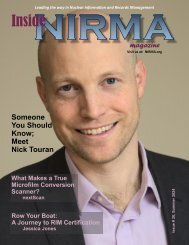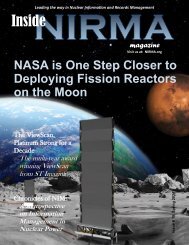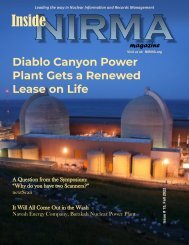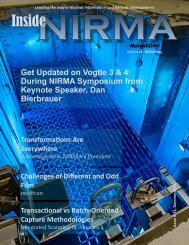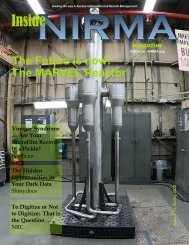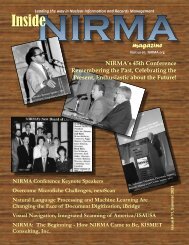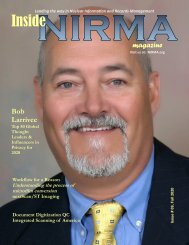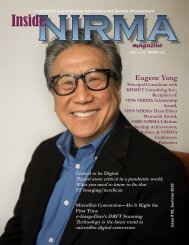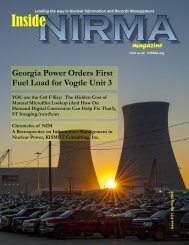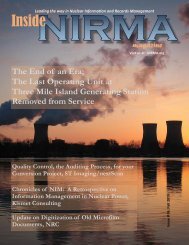Inside NIRMA Spring 2021
Create successful ePaper yourself
Turn your PDF publications into a flip-book with our unique Google optimized e-Paper software.
A Retrospective on Information Management<br />
in Nuclear Power<br />
s I have consulted, sometimes I get frustrated about how<br />
A<br />
records management is viewed, especially electronic<br />
records. Don’t get me wrong; I’ve ridden the wave of<br />
the evolution (revolution?) of moving from paper-based<br />
to going completely digital regarding records. What<br />
concerns me is the mis-understanding of the “why’s” of electronic<br />
records management. Over the course of several columns, I’m<br />
going to address the fundamentals of electronic records, in the<br />
nuclear power context.<br />
Over the past decade or so, I have frequently<br />
provided a workshop at the annual <strong>NIRMA</strong> Conference<br />
on the fundamentals of electronic records. I did this<br />
primarily for the “newbies” who have been recently<br />
hired into a nuclear power plant – helping them<br />
understand the “why’s” on what they are doing. What’s<br />
been heartening, at times, is to see records management<br />
veterans also attend who have been doing “this<br />
electronic thing” for years; I like to think that they’re<br />
reminding themselves of the basics. I’ve done a lot of<br />
martial arts training in my life, and you can never do<br />
enough kicking, punching and throwing; even though<br />
you may have done a move a thousand times, there’s<br />
always a nuance you pick up that could give you that<br />
extra edge.<br />
So, let’s get started.<br />
By Eugene Y. Yang,<br />
Principal Consultant<br />
KISMET Consulting, Inc.<br />
Fundamental #1:<br />
What’s a record?<br />
The Miriam-Webster Dictionary states that a record<br />
is “something that recalls or relates past events, an<br />
official document that records the acts of a public body<br />
or officer, or an authentic official copy of a document<br />
deposited with a legally designated officer.”<br />
In <strong>NIRMA</strong> TG15-2011, “Management of Electronic<br />
Records,” the Association’s position is<br />
that a record is “Information regardless<br />
of physical form or characteristics,<br />
appropriate for preservation as evidence<br />
of the organization, functions, policies,<br />
decisions, procedures, operations, or<br />
other activities of the organization.<br />
Examples of where this information<br />
may reside are: books, papers, maps, photographs,<br />
machine readable electronic files, or other documentary<br />
materials.”<br />
When it comes to managing records,<br />
in the International Standards<br />
Organization (ISO) space, ISO 15489-1,<br />
“Records Management” states that<br />
“Organizations should create and maintain<br />
authentic, reliable and useable records, and<br />
protect the integrity of those records for as long<br />
as required.”<br />
14 <strong>Spring</strong> <strong>2021</strong> <strong>NIRMA</strong>.org <strong>Inside</strong> <strong>NIRMA</strong>



